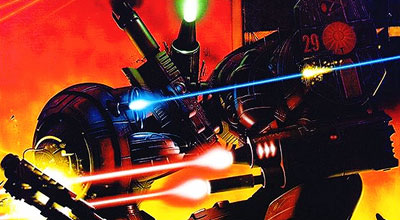Is Battletech hurting the Mechwarrior series?
Local Ditch Gaming > Mechwarrior > Thoughts > Is Battletech Hurting Mechwarrior?

I pose a question: Is Battletech hurting the Mechwarrior series?
Now, I don't mean the Battletech universe, which provides the backdrops, stories, history, and fuel for the fire, if you will, for the Mechwarrior games. Much of the games' atmosphere is developed by trying to recreate the years of battle, broken loyalties, and despair caused by the warring nations described in the BTech lore. All of it helps make Mechwarrior that much more believable. Instead of having a series of "one man versus the world" stories that occupy many games, the battles fit into a larger piece of the pie.
No, I think the universe is great and adds a lot of depth.
Instead I'm referring to the rules and instructions that are described in the tabletop game. There is a certain appeal to having two 75-ton humanoid machines hell-bent on destroying each other. Battletech took this concept and turned it into the tabletop war game that we know today, with hexagon-covered maps, armor sheets, and miniatures. It's stood the test of time, and as such, is a good representation of Mech fighting on the table.
A lot of thought had to be placed into how much damage a weapon could do, how far away it could fire, how fast a unit could walk, how much space it would occupy, etc. In reality, there would be near-limitless possibilities of what could happen to a mech. To make the tabletop game simulate all of this, it was worked into a set of rules that would be manageable.
Along the way, the Mechwarrior series is released on the PC. For the most part, the same rules, guidelines and statistics have been used as found in the tabletop Battletech. This isn't without merit, as there is definitely reason to keep in line with the Battletech lore and history. However, I think there's a lot more that can be done.
As a game, Mechwarrior is primarily about destruction - the destruction of buildings, of ships, of aerospace fighters, but mostly of other Mechs. Because of this, the damage system and weapons balance is one of the most important facets of the game. To this point, almost all of the Mechwarrior games have adopted (for the most part), the classic Battletech system, where there are hit zones for the arms, legs, head, rear, and left, right, and center torso. A weapon does a specific amount of damage and a part is considered destroyed when all of its armor and internal structure points have been depleted.
In the tabletop game, a mech's destruction and the fight itself is left to the imagination. As the armor points are filled in on the Mech sheet, a person can imagine the hits and damage the mech is taking. When a mech is destroyed, they can see the giant machine falling over and dropping down, or its leg blowing off as the mech trips over itself, or even the chasms left from the axe of a Hatchetman.
The Mechwarrior videogames have been a, albeit imperfect, replica of Battletech tabletop game. The rules for how and where damage is score are starting to limit what Mechwarrior games can do. In a game like 2000's Solider of Fortune, there were 26 independent hit zones available. In its sequel, there were over 30. Why not implement something like that into the Mechwarrior games? In 1989, when the original was released it may have been a technological limit, but now it is not.
Of course, such a system would need a change in the way that armor is distributed or held up. But now, the question becomes, "What exactly does a point of armor represent?" How long is a turn in Battletech? How much damage can be dealt in a given time? What would one shot to a smaller hit zone do?
After the issues with legging in MW2 and 3, Mechwarrior 4 had amplified the leg armor. Why? It was all in the name of playability. In the board game, the dice would determine where a weapon would strike, generally peppering the mech all over. Not so in the videogames, where players could hammer all of their attacks at a specific location. Losing all mobility due to several leg hits when the rest of the mech was in pristine condition was no fun. The developers had to create a remedy..
While the leg damage may have been taken too far (I think at some point a leg should be able to be completely detached from a mech), it definitely helped the game. A person could still be legged, but it was a more evenly balanced, with other firing choices.
With a revised damage system, changes like this would surely have to take place, but it could help open up several options and create a more "realistic" experience. Why does taking a shot to the fingers of a Battlemech affect the entire arm? Does this make sense? Though it could be argued that fictional armor spreads damage evenly, I think it would be more immersive if just the finger was damaged. What if an entire autocannon is unloaded on a mech's hand? It seems like it should be destroyed, right? Under the current system, that won't happen, unless the entire arm is shot off.
What's the point? Battletech is an approximation of giant robots battling that was created to suit the pen, paper and dice environment. The Mechwarrior videogames are an approximation of a pen-and-paper approximation of giant robots battling. Sometimes, the rules and limits set forth by board game restrict the playability of the PC games.
Why not go straight to the source?
4/11/09
 Local Ditch Gaming
Local Ditch Gaming